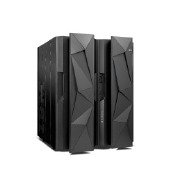IBM today announced the z13 mainframe, calling it the most sophisticated computer system ever built. It is the first major refresh for the System z line since 2012.
The new machine supports up to 141 CPU units - a custom 8-core CPU is used with 10TB of memory and 8K virtual servers. The system has real-time encryption and analytics to help meet expectations of consumers for speed and safety for the trillions of transactions in the mobile economy.
The z13 system cost IBM $1bn to produce, five years to develop and includes the collaboration of more than 60 IBM clients. Additionally, the z13 is based on open standards, fully supporting Linux and OpenStack. Other features include faster/more reliable I/O connectivity, cryptography and compression co-processors for each CPU, and architecture changes meant to boost analytics workload performance. Like other System z hardware, it runs both Linux and IBM’s proprietary z/OS (updated to offer faster analytics and data serving). IBM claims the z13 can handle 2.5B transactions/day.
The z13 features the world’s fastest microprocessor, which is twice as fast as the most common server processors, has 300 percent more memory, 100 percent more bandwidth and vector processing analytics to speed mobile transactions.
As a result, the z13 transaction engine is capable of analyzing transactions in “real time” and will be able to help prevent fraud as it is occurring, allowing financial institutions to halt the transaction before the consumer is affected.
IBM makes some big claims for the new mainframe including:
- 1) That it is the first system able to process 2.5 billion transactions a day - equivalent of 100 Cyber Mondays every day of the year. IBM estimates this will grow to 40 trillion mobile transactions per day by 2025.
2) That z13 is the first system to make practical real-time encryption of all mobile transactions at any scale. z13 speeds real-time encryption of mobile transactions to help protect the transaction data and ensure response times consistent with a positive customer experience.
3) The system includes 500 new patents including cryptographic encryption technologies that enable more security features for mobile initiated transactions.
First system with embedded analytics
z13 is the first mainframe system with embedded analytics providing real-time insights on all transactions. This capability can help guarantee the ability of the client to run real-time fraud detection on 100 percent of their business transactions by delivering ‘on the fly’ analytic insights that, IBM claims, are 17X faster than compared competitive systems at a cheaper cost. The rapid growth of mobile applications has created consumers who expect mobile transactions to be fast and seamless – regardless of which mobile payment platform, retailer, or financial organization is providing the service. As a result, businesses are being forced to evaluate whether their IT infrastructures can support mobile applications that meet and exceed these consumer expectations — or face the potential of losing clients to competing businesses.
Tom Rosamilia, senior vice president, IBM Systems (above) said: “Every time a consumer makes a purchase or hits refresh on a smart phone, it can create a cascade of events on the back end of the computing environment. The z13 is designed to handle billions of ctions for the mobile economy. Only the IBM mainframe can put the power of the world’s most secure datacenters in the palm of your hand. Consumers expect fast, easy and secure mobile transactions. The implication for business is the creation of a secure, high performance infrastructure with sophisticated analytics.”
IBM has designed the z13 to integrate real-time scoring and guarantees this capability as a feature of the system. This scoring can be used for fraud detection on 100 percent of a client’s business transactions.
Embracing customer loyalty
Businesses looking to enhance their customer loyalty programs will be able to use new z13 capabilities to add more personalization by gaining a real-time view of a client’s purchasing habits to offer up-sell and cross-sell promotions before they leave the store — and in some cases before they even enter.
Businesses today don’t have the ability to analyze 100 percent of a consumer’s transaction. With the z13, businesses will be able to use IBM’s predictive analytics modeling technology, SPSS, and personalize the transaction as it occurs.
The z13 includes new support for Hadoop, enabling unstructured data to be more accurately and quickly analyzed. Other analytics advances include faster acceleration of queries by adding DB2 BLU for Linux providing an in-memory database, enhancements to the IBM DB2 analytics accelerator and improved performance for analytics workloads.
The z13 is capable of running up to 8,000 virtual servers - more than 50 virtual servers per core, helping to lower software, energy and facilities costs.
Lower the cost of the cloud
The z13 lowers the cost of running cloud. For compared environments, it is estimated that a z Systems cloud on a z13 will have a 32 per cent lower total cost of ownership over three years than an x86 cloud and a 60 per cent lower total cost of ownership over three years than a public cloud.
As part of today’s announcement, IBM will also unveil a preview of new z/OS software that delivers advanced analytic and data serving capabilities. When available, this new operating system will expand the ability of z13 to process in-memory analytics and provide analysis on mobile transactions, helping clients to further extend mainframe enterprise applications to the mobile user.
The refresh has been a long time coming. IBM’s hardware division sales fell 15% Y/Y in Q3 amid share losses to HP, Dell, EMC, and many more rivals. With customers appear to be waiting for the new model, System z sales fell 35%. Hardware sales drive a sizable amount of software/services revenue.

